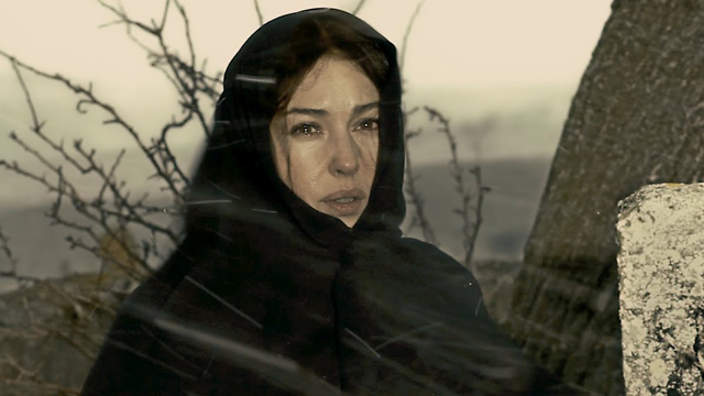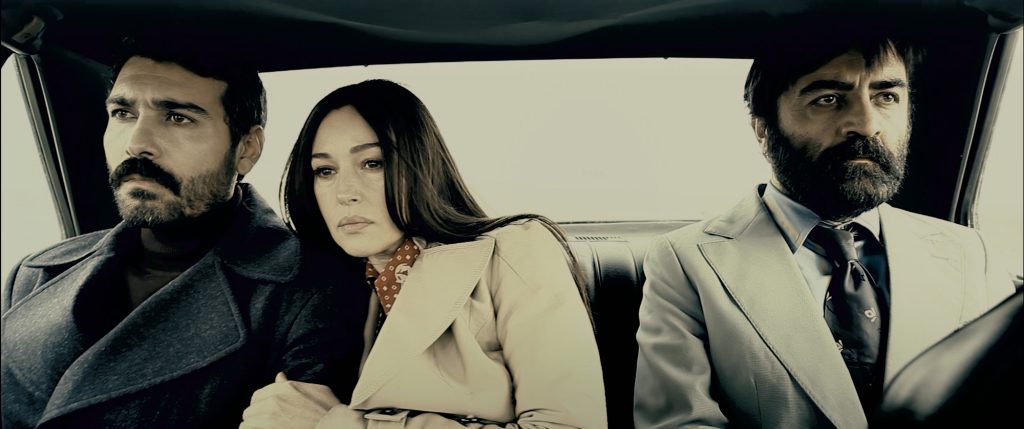The Rhino Season – Revenge Time
Bahman Ghobadi’s recent feature film “The Rhino Season” was screened at the UCLA celebration of Iranian cinema recently and I finally had the chance to watch this film on the big screen even though VOA network had recently screened it both on TV and their YouTube channel already.
I’m glad that I went to see this movie in the theater hall of The Hammer museum down in Westwood, despite a heavy traffic on 405 as usual, because for me the most captivating aspect of this film comes down to its great cinematography which is masterfully conducted by Tooraj Aslani, A visual talent and a superb and creative visionary that almost saves this film.

Ghobadi’s film conveys the story of a jailed Kurdish poet, played by famous Iranian actor in exile Behruz Vosughi, who after being released from a thirty year prison sentence is searching for his wife, played by Monicca Belucci. A simple plot that is packed with several flashbacks into tempestuous days of the Iranian Islamic Revolution.
After watching “Nobody knows about Persian cats” and “A time for the drunken horses”, two of Ghobadi’s earlier films I was expecting another simple and low budget product with a similar cinematic language typical of Ghobadi, who also had been a Kiarostami disciple and AD for few of the Iranian giants features, but “The Rhino Season” is an entirely new experience for its maker, in which both his techniques of storytelling and visual style are altered into a much more sophisticated ambitions, however I am not quite sure if I can still see the sincerity of his earlier films in here.
The entire story is conveyed within a dark and gloomy color tones and style. The film is full of beautifully shot, surreal moments, hallucinations and flashbacks enriched with great compositions and visual elements, but thematically it fails to fill the growing plot holes and eventually falls into pretentiousness, relying on the atrocities of Iranian regime as a way to explain motivations and to stir emotional response.
The protagonist and his wife become subjects of extreme persecution and abuse, which is to a certain degree incomprehensible, perhaps because of unclear motivations. The return of the man and the powerful screen presence of Vosughi after thirty years to look for his wife offers a refreshing beginning, but alas the film eventually fails to deliver.
Ghobadi chooses to slow down the rhythm and turn his leading actor into a mute observer, perhaps to setup a poetic theme and certain visual style, but except those who admire Vosughi’s facial feature only, the rest lose patience because of all the vague situations and unanswered questions that are never addressed properly.
The man finally finds his wife, but refuses to confront her, instead he unknowingly makes love to the daughter of her wife! Later he plays backgammon with the son of his wife exchanging cold glances with him. We can never fully comprehend what in his mind keeps him from not going on her door, given the fact that he has made the trip to see her after 30 years.
As a big fan of slow paced movies and art house cinema I fully support and understand films that want the audience to do their own thinking, but that’s not what Ghobadi is doing here, but he seems a little lost himself and out of ideas, which puts the burden of the story on the shoulders of the Director of photography, who creates one great shot after another, that despite being rich in visual style lacks the power to move the story forward.

Regardless, Behruz Vosughi’s acting is superb. He hadn’t been into a major film for decades but here he displays his master class acting skills despite the fact that he can’t do much of a talking and all he has is a pair of sad eyes that can convey parallel lines between the imprisonment of the character and the actor’s absence from his profession due to exile.
Also worth mentioning, that as a Farsi speaker I was dismayed about casting of a few roles including that of the antagonist and the wife given their weakness in speaking Farsi, which throws off the Iranian audience completely along the plot every time they utter a word. In addition, having the popular Iranian pop music star Arash casted as one of the supporting roles seems like a cheap marketing attempt to garner publicity which a film of this scale and depth doesn’t really require.
With all this in perspective, as mentioned earlier, cinematography remains to be the films’ greatest asset. Aslani’s visual interpretation of Ghobadi’s story is remarkable. His choice of lighting setup, shots, framing and visual elements are simply amazing. A great choice of color palette to design every setting and a corresponding low key lighting to emphasize on the continuation of the nightmare.
The shots are composed of a series of extreme long shots and extreme close-ups, that perhaps aim to stress the similarities between the settings and the personalities. In my opinion taking the cinematography out of this experience will result into a total disaster, which explains many things.
Finally Ghobadi’s attempt to portray the Iranian officials as pure evils is not very different from the way the makers of the movie “300” portrayed the Persians in their anti Persian propaganda piece and while I understand his frustration with Iranian government, but having seen his previous better films, it’s hard for me to accept The Rhyno Season as an honest work.
